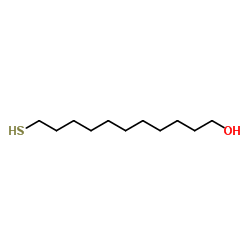11-mercaptoundecanol

11-mercaptoundecanol structure
|
Common Name | 11-mercaptoundecanol | ||
|---|---|---|---|---|
| CAS Number | 73768-94-2 | Molecular Weight | 204.373 | |
| Density | 0.9±0.1 g/cm3 | Boiling Point | 304.0±15.0 °C at 760 mmHg | |
| Molecular Formula | C11H24OS | Melting Point | 33-37ºC | |
| MSDS | Chinese USA | Flash Point | 137.6±20.4 °C | |
| Symbol |

GHS07 |
Signal Word | Warning | |
|
Surface modification-induced phase transformation of hexagonal close-packed gold square sheets.
Nat. Commun. 6 , 6571, (2015) Conventionally, the phase transformation of inorganic nanocrystals is realized under extreme conditions (for example, high temperature or high pressure). Here we report the complete phase transformation of Au square sheets (AuSSs) from hexagonal close-packed ... |
|
|
Design of a surface plasmon resonance immunoassay for therapeutic drug monitoring of amikacin.
Talanta 141 , 253-8, (2015) The therapeutic drug monitoring (TDM) of pharmaceutical drugs with narrow therapeutic ranges is of great importance in the clinical setting. It provides useful information towards the enhancement of drug therapies, aiding in dosage control and toxicity risk m... |
|
|
Application of surface plasmon resonance imaging technique for the detection of single spherical biological submicrometer particles.
Anal. Biochem. 486 , 62-9, (2015) Recent proof-of-principle studies demonstrated the suitability of the surface plasmon resonance imaging (SPRi) technique for the detection of individual submicrometer and nanoparticles in solutions. In the current study, we used the SPRi technique for visuali... |
|
|
A new method and tool for detection and quantification of PM oxidative potential.
Environ. Sci. Pollut. Res. Int. 22 , 12469-78, (2015) Airborne particulate matter (PM) contains several quinones, which are able to generate reactive oxygen species impacting on cell viability. A method able to detect and quantify PM oxidative potential, based on the cytochrome c (cyt-c) reduction by means of su... |
|
|
A Multifaceted Study of Scedosporium boydii Cell Wall Changes during Germination and Identification of GPI-Anchored Proteins.
PLoS ONE 10 , e0128680, (2015) Scedosporium boydii is a pathogenic filamentous fungus that causes a wide range of human infections, notably respiratory infections in patients with cystic fibrosis. The development of new therapeutic strategies targeting S. boydii necessitates a better under... |
|
|
Self‑assembled monolayers of alkanethiolates on surface chemistry groups in osteosarcoma cells.
Mol. Med. Report. 11(2) , 975-81, (2014) Cell biomedical behavior is influenced by a number of factors, and the extracellular matrix (ECM) of the cellular microenvironment affects certain cancer cells. In the current study, U‑2OS cells were cultured on gold surfaces modified with different terminal ... |
|
|
Controlled DNA Patterning by Chemical Lift-Off Lithography: Matrix Matters.
ACS Nano 9 , 11439-54, (2015) Nucleotide arrays require controlled surface densities and minimal nucleotide-substrate interactions to enable highly specific and efficient recognition by corresponding targets. We investigated chemical lift-off lithography with hydroxyl- and oligo(ethylene ... |
|
|
A synthetically modified hydrophobin showing enhanced fluorous affinity.
J. Colloid. Interface Sci. 448 , 140-7, (2015) Hydrophobins are natural surfactant proteins endowed with exceptional surface activity and film-forming capabilities and their use as effective "fluorine-free fluorosurfactants" has been recently reported. In order to increase their fluorophilicity further, h... |
|
|
Polymer brushes interfacing blood as a route toward high performance blood contacting devices.
Macromol. Biosci. 15 , 636-46, (2015) In the current study, well-defined polymer brushes are shown as an effective surface modification to resist the adhesion of whole blood and its components. Poly[oligo(ethylene glycol)methylether methacrylate] (poly(MeOEGMA)), poly(hydroxyethyl methacrylate) (... |
|
|
Binding forces of Streptococcus mutans P1 adhesin.
ACS Nano 9(2) , 1448-60, (2015) Streptococcus mutans is a Gram-positive oral bacterium that is a primary etiological agent associated with human dental caries. In the oral cavity, S. mutans adheres to immobilized salivary agglutinin (SAG) contained within the salivary pellicle on the tooth ... |